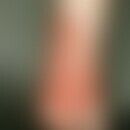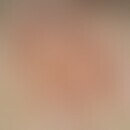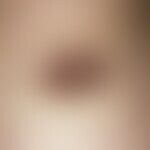Synonym(s)
HistoryThis section has been translated automatically.
Liu, 1949
DefinitionThis section has been translated automatically.
Rare, benign, predominantly eccrine differentiated, more rarely apocrine adenex tumor with predominantly solid structure. The nodular hidradenoma is listed in the literature under numerous names (see above) which can lead to considerable nomenclatural confusion.
You might also be interested in
ManifestationThis section has been translated automatically.
20-70 years (average 37.2 years), rarely > 70 years; m:w=1:2;
LocalizationThis section has been translated automatically.
Capillitium (40%), face (30%), arms (rare legs)
ClinicThis section has been translated automatically.
The clinical picture is not very spectacular and therefore not very specific. There is an acquired, solitary, slow-growing, firm, shifting, non-painful, red or skin-coloured, 0.8-3.5 cm (average 2.0 cm, the maximum was 10 cm) large, (occasionally cystic) lump (or papule) with a smooth, rarely ulcerated surface. The diagnosis is a (histological) random diagnosis. From the (less characteristic) clinical findings only a suspected diagnosis can be made.
HistologyThis section has been translated automatically.
Well-defined cystic or solid tumour formations surrounded by fibrosed connective tissue capsules, predominantly involving the dermis, more rarely the dermis and subcutis. There is no relationship to the normal spanning surface epithelium.
2 cell types are found: a polygonal, roundish or oval, with a vesicular nucleus and eosinophilic cytoplasm. A second, larger cell type with eccentric nucleus and brightened cytoplasm.
A "clearcell" component is often present, also dominating (see below clearcell hidradenoma).
In most cases, tubular or ductal structures can also be detected (tubular adenoma). Signs of apocrine secretion (eosinophilic decapitation phenomena) are occasionally found.
In more than 50% of the cases the formation of horn pearls occurs, whereby hornification can be both trichilemmal and infundibular.
The tumour stroma can become hyalinised or chondroid (see also chondroid syringoma).
Rarely does the accumulation of melanogenic pigment occur.
TherapyThis section has been translated automatically.
Note(s)This section has been translated automatically.
Recurrences with incomplete excision are not rare.
Malignant transformations are rare but occur (according to literature in 6.7% of cases).
See keyword"hidradenoma" which describes an identical tumor portrait.
LiteratureThis section has been translated automatically.
- Bevinahalli N et al.(2012) A study of histopathologic spectrum of nodular hidradenoma. At J Dermatopathol 34: 461-467
- Faulhaber D et al (2000) Clear cell hidradenoma in a young girl. J Am Acad Dermatol 42: 693-695
- Hsu PJ et al (2003) Mixed tubulopapillary hidradenoma and syringocystadenoma papilliferum occurring as a verrucous tumor. J Cutan pathogen 30: 206-210
- Liu Y (1949) The histogenesis of clear cell papillary carcinoma of the skin. J Am Pathol 25: 151-357
- Nandeesh BN et al (2014) A study of histopathologic spectrum of nodular hidradenoma. At J Dermatopathol 34: 461-470
- Sagi A et al (2002) Cystic clear cell hidradenoma of the thumb: case report of a rare hand tumor. Ann Plast Surgery 48: 337-338
- Vodovnik A (2003) Coexpression of S-100 and smooth muscle actin in nodular hidradenoma. At J Dermatopathol 25: 361-362
Disclaimer
Please ask your physician for a reliable diagnosis. This website is only meant as a reference.









